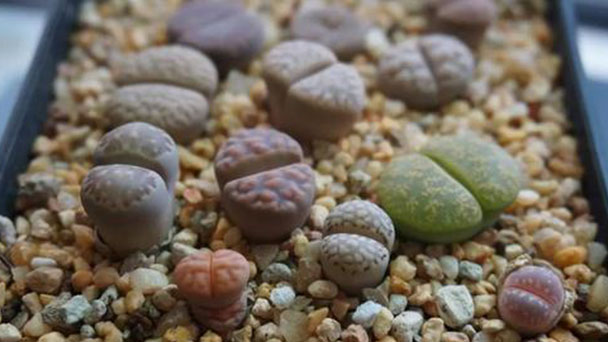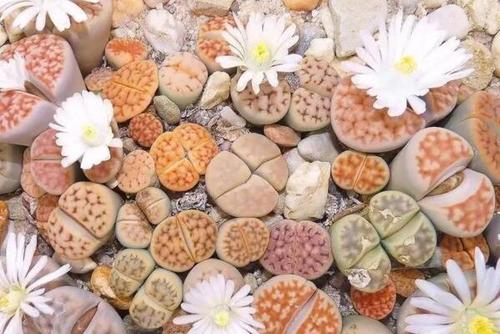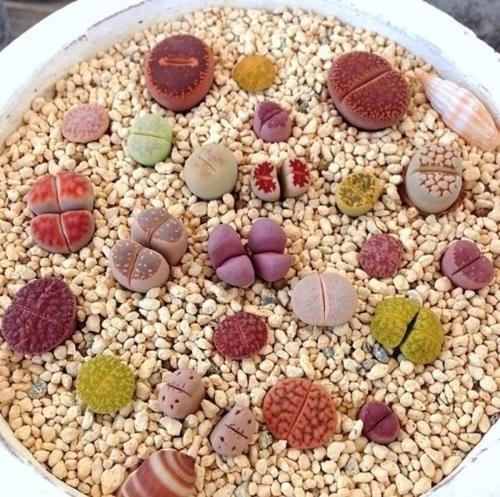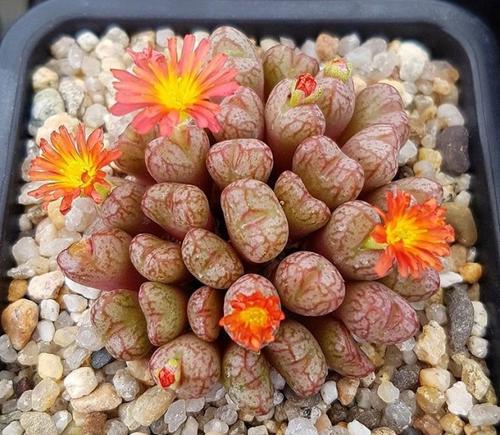Propagation methods of Living Stone
Written by Maggie
Jan 05 2021

Succulent Living Stone is a kind of succulent plant. It has a rare variety, unique shape, beautiful flowers and high ornamental value. Therefore, the price is relatively expensive, and those who want to raise more Living stones can get more pots through reproduction. Propagation methods of Living Stone include sowing seeds or separating plants.

Seed propagation method of Living Stone
Sow in the spring from April to May. Because the seeds are small, indoor pot sowing is usually adopted. After sowing, the soil should be covered with thin soil. The sowing temperature is 15-25℃. Germinate about half a month after sowing. Let the seedlings come out gradually. Seedlings are only the size of soybeans, growth is slow, management must be careful. It takes two to three years for the seedlings to bloom.
Living Stone April-May sowing, small seeds, indoor basin sowing, sowing temperature 22-24℃. Germinate about 7-10 days after sowing. Seedlings are only the size of soybeans. The growth is slow, management must be careful. It takes two to three years for the seedlings to bloom.
As the spring begins to grow, the old plants gradually shrink and are swollen by new ones. We need to reduce water right now, keep basin soil a bit drier, avoid to spray water directly to the plant, in case wound infection causes rot. Move to the indoor semi-light after summer, avoid direct glare, at the same time it should be timely ventilation cooling, and control watering, in order to make it a safe summer. After entering the autumn, gradually increase the amount of water, and apply a small amount of compound fertilizer, to facilitate the flowering of the pregnant bud.
In the winter, it should be more strictly controlled watering, in order to know the basin dry soil had better. Overwintering period should be put in a sunny place, the room temperature is maintained 10 degrees above can overwintering safely namely, but had better put it in the room temperature of 15℃ above. Living Stone has a well-developed root system, so it should be cultivated in a deep basin. The basin soil can be prepared by mixing 4 parts of rotten leaf soil, 3 parts of calcareous materials (shell powder, egg shell powder, old grey wall debris, etc.) and 3 parts of river sand. Planting should not be too deep, otherwise easy to cause plant wipe rot.
Division propagation method of Living Stone
Each spring, new fleshy leaves grow through the cracks in the center, bursting the old leaves and killing them as they shrink. The new leaves grow rapidly, and then shrink and crack in summer, and grow out 2~3 young new plants from the gap, then plant the young plants separately.

https://www.rayagarden.com/how-to-garden/how-to-care-for-living-stone.html
Cutting propagation method of Living Stone
Cutting substrate: it is used for cutting nutrient soil or river sand, mud carbon soil and other materials. It is difficult to get the ideal cutting substrate under the condition of family cutting, so it is suggested to use the prepared and sterilized cutting substrate. Medium and coarse river sand is fine, but flush with water several times before use. Do not use river sand from sea sand and saline-alkali areas. They are not suitable for the growth of flower plants.
In early spring or late autumn (the highest temperature at noon is not more than 28℃, and the lowest temperature at night is not less than 15℃), the leaves or stems should be cut off (with 3 ~ 4 leaves), and inserted into the matrix after the wound is dried, and the cuttings and matrix should be slightly sprayed wet. As long as the matrix is not too dry or water stains, roots and new buds will soon grow. In late spring to early autumn when the temperature is higher, cuttings are easy to decay, it is best not to carry out cutting.
On basin: up the plate, the first in the pelvic floor in a 2 ~ 2 cm thick coarse grained matrix or ceramsite as a filter layer, cover it with full of rotten organic fertilizer as basal, thickness of about 1 ~ 2 cm, then cover with a layer of substrate, about 1 ~ 2 cm thick, and then into the plant, in order to separate the fertilizer from the root, avoid burning roots. The substrate for the upper basin can be selected from the following. Garden soil: slag = 3:1; Or garden soil: medium coarse river sand: sawdust (shavings) = 4:1:2; Or paddy soil, pond mud, one of the leaf rot soil. Or peat + perlite + ceramsite =2 parts +2 parts +1 part; Vegetable garden soil + slag =3 parts +1 part;Peat + slag + ceramsite =2 parts +2 parts +1 part; Sawdust + vermiculite + medium coarse river sand =2 parts +2 parts +1 part. After finishing the pot, pour water into it once, and put it in a shade environment for maintenance for a week.

Latest Updated
- Benefits of Bugleweed - 7 Science-backed Health Benefits
- Bugleweed Dangers & Side Effects - Is It Poisonous?
- How to Plant Evergreen Trees - What You Should Know
- When to Plant Evergreens - Grow Guide for Evergreen Trees
- 12 Wonderful Evergreen Shrubs for Your Garden
- 12 Popular Evergreen Plants with Pictures for Beginners
- When And How To Prune A Lilac Bush Like a Pro
- How to Grow & Care for Lilac Vine (Hardenbergia Violacea)
- Japanese Lilac Tree (Syringa Reticulata) Care & Propagation Guide
- Shumard Oak Pros and Cons - What to Know
Popular Articles
- Winter maintenance of Antirrhinum Majus
- How to Grow Terminalia Mantaly Tree
- How to Grow and Care for Crossostephium Chinense
- How to grow Antirrhinum Majus in spring
- Peristeria Elata (Dove Orchid) Profile: Info & Care Guide
- Underwatered Snake Plant (Sansevieria Trifasciata) - Signs And How To Fix
- How to Care for Brazilian Jasmine Plant (Mandevilla Sanderi)
- How to Grow & Care for Graptopetalum Purple Delight in Summer
- Rosa Chinensis (China Rose): Plant Growing & Care Tips
- How to Care for Baby Sun Rose (Aptenia Cordifolia)